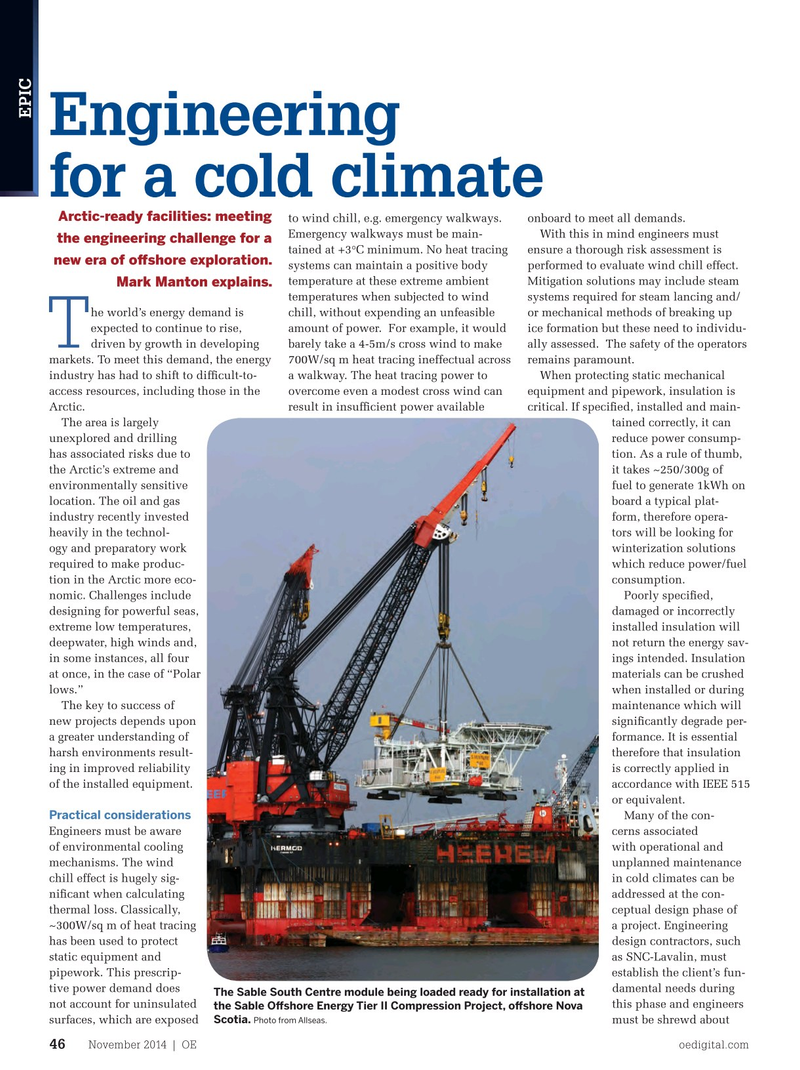
Page 44: of Offshore Engineer Magazine (Nov/Dec 2014)
Read this page in Pdf, Flash or Html5 edition of Nov/Dec 2014 Offshore Engineer Magazine
EPIC
Engineering for a cold climate
Arctic-ready facilities: meeting to wind chill, e.g. emergency walkways. onboard to meet all demands.
Emergency walkways must be main- With this in mind engineers must the engineering challenge for a tained at +3°C minimum. No heat tracing ensure a thorough risk assessment is new era of ofshore exploration. systems can maintain a positive body performed to evaluate wind chill effect. temperature at these extreme ambient Mitigation solutions may include steam
Mark Manton explains.
temperatures when subjected to wind systems required for steam lancing and/ he world’s energy demand is chill, without expending an unfeasible or mechanical methods of breaking up expected to continue to rise, amount of power. For example, it would ice formation but these need to individu-
T driven by growth in developing barely take a 4-5m/s cross wind to make ally assessed. The safety of the operators markets. To meet this demand, the energy 700W/sq m heat tracing ineffectual across remains paramount.
industry has had to shift to diffcult-to- a walkway. The heat tracing power to When protecting static mechanical access resources, including those in the overcome even a modest cross wind can equipment and pipework, insulation is
Arctic. result in insuffcient power available critical. If specifed, installed and main-
The area is largely tained correctly, it can unexplored and drilling reduce power consump- has associated risks due to tion. As a rule of thumb, the Arctic’s extreme and it takes ~250/300g of environmentally sensitive fuel to generate 1kWh on location. The oil and gas board a typical plat- industry recently invested form, therefore opera- heavily in the technol- tors will be looking for ogy and preparatory work winterization solutions required to make produc- which reduce power/fuel tion in the Arctic more eco- consumption. nomic. Challenges include Poorly specifed, designing for powerful seas, damaged or incorrectly extreme low temperatures, installed insulation will deepwater, high winds and, not return the energy sav- in some instances, all four ings intended. Insulation at once, in the case of “Polar materials can be crushed lows.” when installed or during
The key to success of maintenance which will new projects depends upon signifcantly degrade per- a greater understanding of formance. It is essential harsh environments result- therefore that insulation ing in improved reliability is correctly applied in of the installed equipment. accordance with IEEE 515 or equivalent.
Practical considerations
Many of the con-
Engineers must be aware cerns associated of environmental cooling with operational and mechanisms. The wind unplanned maintenance chill effect is hugely sig- in cold climates can be nifcant when calculating addressed at the con- thermal loss. Classically, ceptual design phase of ~300W/sq m of heat tracing a project. Engineering has been used to protect design contractors, such static equipment and as SNC-Lavalin, must pipework. This prescrip- establish the client’s fun- tive power demand does damental needs during
The Sable South Centre module being loaded ready for installation at not account for uninsulated this phase and engineers the Sable Ofshore Energy Tier II Compression Project, ofshore Nova
Scotia. Photo from Allseas. surfaces, which are exposed must be shrewd about
November 2014 | OE oedigital.com 46 046_OE1114_EPIC2_SNC.indd 46 10/21/14 4:34 PM

 43
43

 45
45